Oxygen Vacancy-Rich δ-MnO2 Cathode Materials for Highly Stable Zinc-Ion Batteries
Abstract
1. Introduction
2. Experimental Section
2.1. Preparation of Materials
2.2. Morphology and Structure Characterization
2.3. Electrochemical Characterization
3. Results and Discussion
4. Conclusions
Author Contributions
Funding
Data Availability Statement
Conflicts of Interest
References
- Zhang, J.N.; Xiao, J.F.; Chen, X.F.; Liang, X.M.; Fan, L.Y.; Ye, D.Q. Allowance and allocation of industrial volatile organic compounds emission in China for year 2020 and 2030. J. Environ. Sci. 2018, 69, 155–165. [Google Scholar] [CrossRef] [PubMed]
- Liu, Y.; Liu, Y.; Wu, X.; Cho, Y.R. A facile carbon modification avenue to construct highly stable V2O5 electrode for aqueous zinc ion batteries. ACS Sustain. Chem. Eng. 2023, 11, 13298–13305. [Google Scholar] [CrossRef]
- Fitz, O.; Ingenhoven, S.; Bischoff, C.; Gentischer, H.; Birke, K.P.; Saracsan, D.; Biro, D. Comparison of aqueous-and non-aqueous-based binder polymers and the mixing ratios for Zn//MnO2 batteries with mildly acidic aqueous electrolytes. Batteries 2021, 7, 40. [Google Scholar] [CrossRef]
- Zhang, L.; Yang, S.H.; Fu, W.Q.; Cui, Y.W.; Wang, J.Q.; Zhao, D.G.; Yang, C.; Wang, X.T.; Cao, B.Q. Plasma-induced ε-MnO2 based aqueous zinc-ion batteries and their dissolution-deposition mechanism. J. Mater. Sci. Technol. 2022, 127, 206–213. [Google Scholar] [CrossRef]
- Li, S.L.; Zhao, M.; Zhang, D.D.; Wu, X. High-capacity aqueous Zn/MnO2 batteries: A clue of K ion pre-intercalation. Cryst. Growth Des. 2023, 23, 8156–8162. [Google Scholar] [CrossRef]
- Wang, T.T.; Li, C.P.; Xie, X.S.; Lu, B.G.; He, Z.X.; Liang, S.Q.; Zhou, J. Anode materials for aqueous zinc ion batteries: Mechanisms, properties, and perspectives. ACS Nano 2020, 14, 16321–16347. [Google Scholar] [CrossRef]
- Liu, Y.; Umar, A.; Wu, X. Metal-organic framework derived porous cathode materials for hybrid zinc ion capacitor. Rare Met. 2022, 41, 2985–2991. [Google Scholar] [CrossRef]
- Durena, R.; Zukuls, A. A Short Review: Comparison of Zinc-Manganese dioxide batteries with different pH aqueous electrolytes. Batteries 2023, 9, 311. [Google Scholar] [CrossRef]
- Liu, Y.; Wu, X. Review of vanadium-based electrode materials for rechargeable aqueous zinc ion batteries. J. Energy Chem. 2021, 56, 223–237. [Google Scholar] [CrossRef]
- Chen, L.N.; An, Q.Y.; Mai, L.Q. Recent advances and prospects of cathode materials for rechargeable aqueous zinc-ion batteries. Adv. Mater. Interfaces 2019, 6, 1900387. [Google Scholar] [CrossRef]
- Zhang, J.J.; Wu, X. Dual-ion carrier storage through Mg2+ addition for high-energy and long-life zinc-ion hybrid capacitor. Int. J. Min. Met. Mater. 2024, 31, 179–185. [Google Scholar] [CrossRef]
- Yan, M.Y.; He, P.; Chen, Y.; Wang, S.Y.; Wei, Q.L.; Zhao, K.N.; Xu, X.; An, Q.Y.; Shuang, Y.; Shao, Y.Y.; et al. Water-lubricated intercalation in V2O5·nH2O for high-capacity and high-rate aqueous rechargeable zinc batteries. Adv. Mater. 2018, 30, 1703725. [Google Scholar] [CrossRef] [PubMed]
- Liu, Y.; Liu, Y.; Wu, X. Defect engineering of vanadium-based electrode materials for zinc ion battery. Chinese Chem. Lett. 2023, 34, 107839. [Google Scholar] [CrossRef]
- Zhang, N.; Cheng, F.Y.; Liu, Y.C.; Zhao, Q.; Lei, K.X.; Chen, C.C.; Liu, X.S.; Chen, J. Cation-deficient spinel ZnMn2O4 cathode in Zn (CF3SO3)2 electrolyte for rechargeable aqueous Zn-ion battery. J. Am. Chem. Soc. 2016, 138, 12894–12901. [Google Scholar] [CrossRef]
- Pan, H.L.; Shao, Y.Y.; Yan, P.F.; Cheng, Y.W.; Han, K.S.; Nie, Z.M.; Wang, C.M.; Yang, J.H.; Li, X.L.; Bhattacharya, P.; et al. Reversible aqueous zinc/manganese oxide energy storage from conversion reactions. Nat. Energy 2016, 1, 16039. [Google Scholar] [CrossRef]
- Sun, W.; Wang, F.; Hou, S.Y.; Yang, C.Y.; Fan, X.L.; Ma, Z.H.; Han, F.D.; Hu, R.D.; Zhu, M.; Wang, C.S. Zn/MnO2 battery chemistry with H+ and Zn2+ co-insertion. J. Am. Chem. Soc. 2017, 139, 9775–9778. [Google Scholar] [CrossRef]
- Zhang, L.Y.; Chen, L.; Zhou, X.F.; Liu, Z.P. Towards high-voltage aqueous metal-ion batteries beyond 1.5 V: The zinc/zinc hexacyanoferrate system. Adv. Energy Mater. 2015, 5, 1400930. [Google Scholar] [CrossRef]
- Trócoli, R.; Mantia, F. An aqueous zinc-ion battery based on copper hexacyanoferrate. ChemSusChem 2015, 8, 481–485. [Google Scholar] [CrossRef]
- Wang, K.H.; Shangguan, M.L.; Zhao, Y.B.; Tian, H.R.; Wang, F.; Yuan, J.L.; Lan, X. Flexible and stable n-isopropylacrylamide/sodium alginate gel electrolytes for aqueous Zn-MnO2 batteries. Batteries 2023, 9, 426. [Google Scholar] [CrossRef]
- Zhao, Q.; Huang, W.W.; Luo, Z.Q.; Liu, L.J.; Lu, Y.; Li, Y.X.; Ma, H.; Chen, J. High-capacity aqueous zinc batteries using sustainable quinone electrodes. Sci. Adv. 2018, 4, 1761. [Google Scholar] [CrossRef]
- Wen, S.; Gu, X.; Ding, X.W.; Dai, P.C.; Zhang, D.J.; Li, L.J.; Liu, D.D.; Zhao, X.B.; Yang, J. Boosting fast and stable alkali metal ion storage by synergistic engineering of oxygen vacancy and amorphous structure. Adv. Funct. Mater. 2021, 32, 2106751. [Google Scholar] [CrossRef]
- Xie, H.X.; Cui, J.X.; Yao, Z.; Ding, X.K.; Zhang, Z.H.; Luo, D.; Lin, Z. Revealing the role of spinel phase on Li-rich layered oxides: A review. Chem. Eng. J. 2022, 427, 131978. [Google Scholar] [CrossRef]
- Luo, H.; Wang, B.; Jian, J.H.; Wu, F.D.; Peng, L.; Wang, D.L. Stress-release design for high-capacity and long-time lifespan aqueous zinc-ion batteries. Mater. Today Energy 2021, 21, 100799. [Google Scholar] [CrossRef]
- Yadav, P.; Putro, D.; Kim, J.; Rai, A.K. Pom-pom flower-like morphology of δ-MnO2 with superior electrochemical performances for rechargeable aqueous zinc ion batteries. Batteries 2023, 9, 133. [Google Scholar] [CrossRef]
- Liu, Y.; Liu, Y.; Wu, X.; Cho, Y.R. Enhanced electrochemical performance of Zn/VOx batteries by a carbon-encapsulation strategy. ACS Appl. Mater. Interfaces 2022, 14, 11654–11662. [Google Scholar] [CrossRef]
- Cao, Z.W.; Zhang, H.; Song, B.; Xiong, D.Y.; Tao, S.S.; Deng, W.T.; Hu, J.G.; Hou, H.S.; Zou, G.Q.; Ji, X.B. Angstromlevel ionic sieve 2D-MOF membrane for high power aqueous zinc anode. Adv. Funct. Mater. 2023, 33, 2300339. [Google Scholar] [CrossRef]
- Liu, C.; Deng, L.J.; Li, X.Z.; Wu, T.; Zhang, W.J.; Cui, H.S.; Yang, H. Metal–organic frameworks for solid-state electrolytes: A mini review. Electrochem. Commun. 2023, 150, 107491. [Google Scholar] [CrossRef]
- Wei, C.G.; Xu, C.J.; Li, B.H.; Du, H.D.; Kang, F.Y. Preparation and characterization of manganese dioxides with nano-sized tunnel structures for zinc ion storage. J. Phys. Chem. Solids 2012, 73, 1487–1491. [Google Scholar] [CrossRef]
- Alfaruqi, M.H.; Islam, S.; Putro, D.Y.; Mathew, V.; Kim, S.; Jo, J.; Kim, S.; Sun, Y.K.; Kim, K.; Kim, J. Structural transformation and electrochemical study of layered MnO2 in rechargeable aqueous zinc-ion battery. Electrochim. Acta 2018, 276, 1–11. [Google Scholar] [CrossRef]
- Huang, J.H.; Wang, Z.; Hou, M.Y.; Dong, X.L.; Liu, Y.; Wang, Y.G.; Xia, Y.Y. Polyaniline-intercalated manganese dioxide nanolayers as a high-performance cathode material for an aqueous zinc-ion battery. Nat. Commun. 2018, 9, 2906. [Google Scholar] [CrossRef]
- Jiang, J.; Xu, T.; Lu, J.P.; Sun, L.T.; Ni, Z.H. Defect engineering in 2D materials: Precise manipulation and improved functionalities. Research 2019, 2019, 4641739. [Google Scholar] [CrossRef] [PubMed]
- Xie, C.; Yan, D.F.; Chen, W.; Zou, Y.Q.; Chen, R.; Zang, S.Q.; Wang, Y.Y.; Yao, X.D.; Wang, Y.Y.; Yao, X.D.; et al. Insight into the design of defect electrocatalysts: From electronic structure to adsorption energy. Mater. Today 2019, 31, 47–68. [Google Scholar] [CrossRef]
- Zhao, J.; Cheng, H.; Zhang, Z.H.; Liu, Y.; Song, J.N.; Liu, T.; He, Y.N.; Meng, A.L.; Sun, C.L.; Hu, M.; et al. The semicoherent interface and vacancy engineering for constructing Ni(Co)Se2@Co(Ni)Se2 heterojunction as ultrahigh-rate battery-type supercapacitor cathode. Adv. Funct. Mater. 2022, 32, 2202063. [Google Scholar] [CrossRef]
- Zheng, Y.J.; Yao, Z.G.; Shadike, Z.; Lei, M.; Liu, J.J.; Li, C.L. Defect concentration-mediated T-Nb2O5 anodes for durable and fast charging Li-ion batteries. Adv. Funct. Mater. 2022, 32, 2107060. [Google Scholar] [CrossRef]
- Zhao, Y.X.; Chang, C.; Teng, F.; Zhao, Y.F.; Chen, G.B.; Shi, R.; Waterhouse, G.; Huang, W.F.; Zhang, T.R. Defect-engineered ultrathin δ-MnO2 nanosheet arrays as bifunctional electrodes for efficient overall water splitting. Adv. Energy Mater. 2017, 7, 1700005. [Google Scholar] [CrossRef]
- Pan, X.Y.; Yang, M.Q.; Fu, X.Z.; Zhang, N.; Xu, Y.J. Defective TiO2 with oxygen vacancies: Synthesis, properties and photocatalytic applications. Nanoscale 2013, 5, 3601–3614. [Google Scholar] [CrossRef]
- Li, Y.; Qian, J.; Zhang, M.H.; Wang, S.; Wang, Z.H.; Li, M.S.; Bai, Y.; An, Q.Y.; Xu, H.J.; Wu, F. Co-construction of sulfur vacancies and heterojunctions in tungsten disulfide to induce fast electronic/ionic diffusion kinetics for sodium-ion batteries. Adv. Mater. 2020, 32, 2005802. [Google Scholar] [CrossRef]
- Yao, W.Q.; Tian, C.H.; Yang, C.; Xu, J.; Meng, Y.F.; Manke, I.; Chen, N.; Wu, Z.L.; Zhan, L.; Wang, Y.L.; et al. P-doped NiTe2 with Te-vacancies in lithium-sulfur batteries prevents shuttling and promotes polysulfide conversion. Adv. Mater. 2022, 34, 2106370. [Google Scholar] [CrossRef]
- Zhao, M.; Li, S.L.; Wu, X.; Luo, S.H. Gallium ion pre-insertion protocol to (NH4)2V10O25·8H2O cathode materials for reversible aqueous Zn battery. Adv Mater. Technol. 2024, 9, 2400125. [Google Scholar] [CrossRef]
- Liu, W.; Su, Q.M.; Zhu, R.R.; Shi, W.H.; Zhang, F.; Du, G.H.; Zhao, W.Q.; Zhao, M.; Xu, B.S. Chemical lithiation-induced oxygen vacancies in MnO2 at room temperature for aqueous zinc-ion batteries. ACS Appl. Energy Mater. 2023, 6, 6689–6699. [Google Scholar] [CrossRef]
- Yang, J.; Xiao, X.; Chen, P.; Zhu, K.; Cheng, K.; Ye, K.; Wang, G.L.; Cao, D.X.; Yan, J. Creating oxygen-vacancies in MoO3−x nanobelts toward high volumetric energy-density asymmetric supercapacitors with long lifespan. Nano Energy 2019, 58, 455–465. [Google Scholar] [CrossRef]
- Zhang, Y.Y.; Chen, P.; Wang, Q.Y.; Wang, Q.; Zhu, K.; Ye, K.; Wang, G.L.; Cao, D.X.; Yan, J.; Zhang, Q. High capacity and kinetically accelerated lithium storage in MoO3 enabled by oxygen vacancies and heterostructure. Adv. Energy Mater. 2021, 11, 2101712. [Google Scholar] [CrossRef]
- Zhai, X.Z.; Qu, J.; Hao, S.M.; Jing, Y.Q.; Chang, W.; Wang, J.; Li, W.; Abdelkrim, Y.; Yuan, H.F.; Yu, Z.Z. Layered birnessite cathode with a displacement/intercalation mechanism for high-performance aqueous zinc-ion batteries. Nano-Micro Lett. 2020, 12, 56. [Google Scholar] [CrossRef] [PubMed]
- Lu, Y.Q.; Deng, H.; Pan, T.T.; Zhang, C.B.; He, H. Thermal annealing induced surface oxygen vacancy clusters in α-MnO2 nanowires for catalytic ozonation of VOCs at ambient temperature. ACS Appl. Mater. Interfaces 2023, 15, 9362–9372. [Google Scholar] [CrossRef]
- Zhang, J.; He, T.; Zhang, W.; Sheng, J.Z.; Amiinu, I.S.; Kou, Z.K.; Yang, J.L.; Mai, L.Q.; Mu, S.C. Na Mn-O nanocrystals as a high capacity and long-life anode material for Li-ion batteries. Adv. Energy Mater. 2017, 7, 1602092. [Google Scholar] [CrossRef]
- Wang, S.; Li, L.; He, W.; Shao, Y.; Li, Y. Oxygen vacancy modulation of bimetallic oxynitride anodes toward advanced Li-ion capacitors. Adv. Funct. Mater. 2020, 30, 2000350. [Google Scholar] [CrossRef]
- Zhang, Z.C.Y.; Xi, B.J.; Wang, X.; Ma, X.J.; Chen, W.H.; Feng, J.K.; Xiong, S.L. Oxygen defects engineering of VO2·xH2O nanosheets via in situ polypyrrole polymerization for efficient aqueous zinc ion storage. Adv. Funct. Mater. 2021, 31, 2103070. [Google Scholar] [CrossRef]
- Alfaruqi, M.H.; Mathew, V.; Gim, J.; Kim, S.; Song, J.; Baboo, J.P.; Choi, S.H.; Kim, J. Electrochemically induced structural transformation in a γ-MnO2 cathode of a high capacity zinc-ion battery system. Chem. Mater. 2015, 27, 3609–3620. [Google Scholar] [CrossRef]
- Guo, C.; Zhou, Q.H.; Liu, H.M.; Tian, S.; Chen, B.L.; Zhao, J.; Li, J.F. A case study of β-and δ-MnO2 with different crystallographic forms on ion-storage in rechargeable aqueous zinc ion battery. Electrochem. Acta 2019, 324, 134867. [Google Scholar] [CrossRef]
- Liu, Y.; Wu, X. Hydrogen and sodium ions Co-intercalated vanadium dioxide electrode materials with enhanced zinc ion storage capacity. Nano Energy 2021, 86, 106124. [Google Scholar] [CrossRef]
- Bai, Y.C.; Zhang, H.; Xiang, B.; Yao, Q.; Dou, L.; Dong, G.Y. Engineering porous structure in Bi-component-active ZnO quantum dots anchored vanadium nitride boost’s reaction kinetics for zinc storage. Nano Energy 2021, 89, 106386. [Google Scholar] [CrossRef]
- Xiong, T.; Yu, Z.G.; Wu, H.J.; Du, Y.H.; Xie, Q.D.; Chen, J.S.; Xue, J.M. Defect engineering of oxygen-deficient manganese oxide to achieve high-performing aqueous zinc ion battery. Adv. Energy Mater. 2019, 9, 1803815. [Google Scholar] [CrossRef]
- Li, N.; Hou, Z.D.; Liang, S.Y.; Cao, Y.J.; Liu, H.Y.; Hua, W.; Wei, C.G.; Kang, F.Y.; Wang, J.G. Highly flexible MnO2@polyaniline core-shell nanowire film toward substantially expedited zinc energy storage. Chem. Eng. J. 2023, 452, 139408. [Google Scholar] [CrossRef]
- Xie, Q.X.; Cheng, G.; Xue, T.; Huang, L.H.; Chen, S.H.; Sun, Y.; Sun, M.; Wang, H.Z.; Yu, L. Alkali ions pre-intercalation of δ-MnO2 nanosheets for high-capacity and stable Zn-ion battery. Mater. Today Energy 2022, 24, 100934. [Google Scholar] [CrossRef]
- Zhao, Y.J.; Zhang, P.J.; Liang, J.R.; Xia, X.Y.; Ren, L.T.; Li, S.; Liu, W.; Sun, X.M. Uncovering sulfur doping effect in MnO2 nanosheets as an efficient cathode for aqueous zinc ion battery. Energy Storage Mater. 2022, 47, 424–433. [Google Scholar] [CrossRef]
- Alfaruqi, M.H.; Islam, S.; Mathew, V.; Song, J.; Kim, S.; Tung, D.P.; Kim, J. Ambient redox synthesis of vanadium-doped manganese dioxide nanoparticles and their enhanced zinc storage properties. Appl. Surf. Sci. 2017, 404, 435–442. [Google Scholar] [CrossRef]
- Tang, H.; Chen, W.H.; Li, N.; Hu, Z.L.; Xiao, L.; Xie, Y.J.; Xi, L.J.; Ni, L.; Zhu, Y.R. Layered MnO2 nanodots as high-rate and stable cathode materials for aqueous zinc-ion storage. Energy Storage Mater. 2022, 48, 335–343. [Google Scholar] [CrossRef]
- Zhao, C.R.; Liu, Y.; Li, S.L.; Wu, X.; Liu, J.H. PVP decorated H3.78V6O13 microspheres assembled by nanosheets for aqueous zinc ion batteries at variable work temperature. Chinese Chem. Lett. 2024, 2024, 110185. [Google Scholar] [CrossRef]
- Liu, S.C.; Zhu, H.; Zhang, B.H.; Zhu, H.K.; Ren, Y.; Geng, H.B.; Li, Q.; Li, C.C. Tuning the kinetics of zinc-ion insertion/extraction in V2O5 by in situ polyaniline intercalation enables improved aqueous zinc-ion storage performance. Adv. Mater. 2020, 32, 2001113. [Google Scholar] [CrossRef]
- Yang, X.; Deng, W.Z.; Chen, M.; Wang, Y.B.; Sun, C.F. Mass-producible, quasi-zero-strain, lattice-water-rich inorganic open frameworks for ultrafast-charging and long-cycling zinc-ion batteries. Adv. Mater. 2020, 32, 2003592. [Google Scholar] [CrossRef]
- Yang, S.H.; Zhang, L.; Luo, M.J.; Cui, Y.W.; Wang, J.Q.; Zhao, D.G.; Yang, C.; Wang, X.T.; Cao, B.Q. Synergistic combination of a Co-doped σ-MnO2 cathode with an electrolyte additive for a high-performance aqueous zinc-ion battery. ChemPhysMater 2023, 2, 77–82. [Google Scholar] [CrossRef]
- Liu, F.; Chen, Z.X.; Fang, G.Z.; Wang, Z.Q.; Cai, Y.S.; Tang, B.Y.; Zhou, J.; Liang, S.Q. V2O5 nanospheres with mixed vanadium valences as high electrochemically active aqueous zinc-ion battery cathode. Nano-Micro Lett. 2019, 11, 25. [Google Scholar] [CrossRef] [PubMed]
- Xu, J.W.; Gao, Q.L.; Xia, Y.M.; Lin, X.S.; Liu, W.L.; Ren, M.M.; Kong, F.G.; Wang, S.J.; Lin, C. High-performance reversible aqueous zinc-ion battery based on iron-doped alpha-manganese dioxide coated by polypyrrole. J. Colloid Interface Sci. 2021, 598, 419–429. [Google Scholar] [CrossRef] [PubMed]
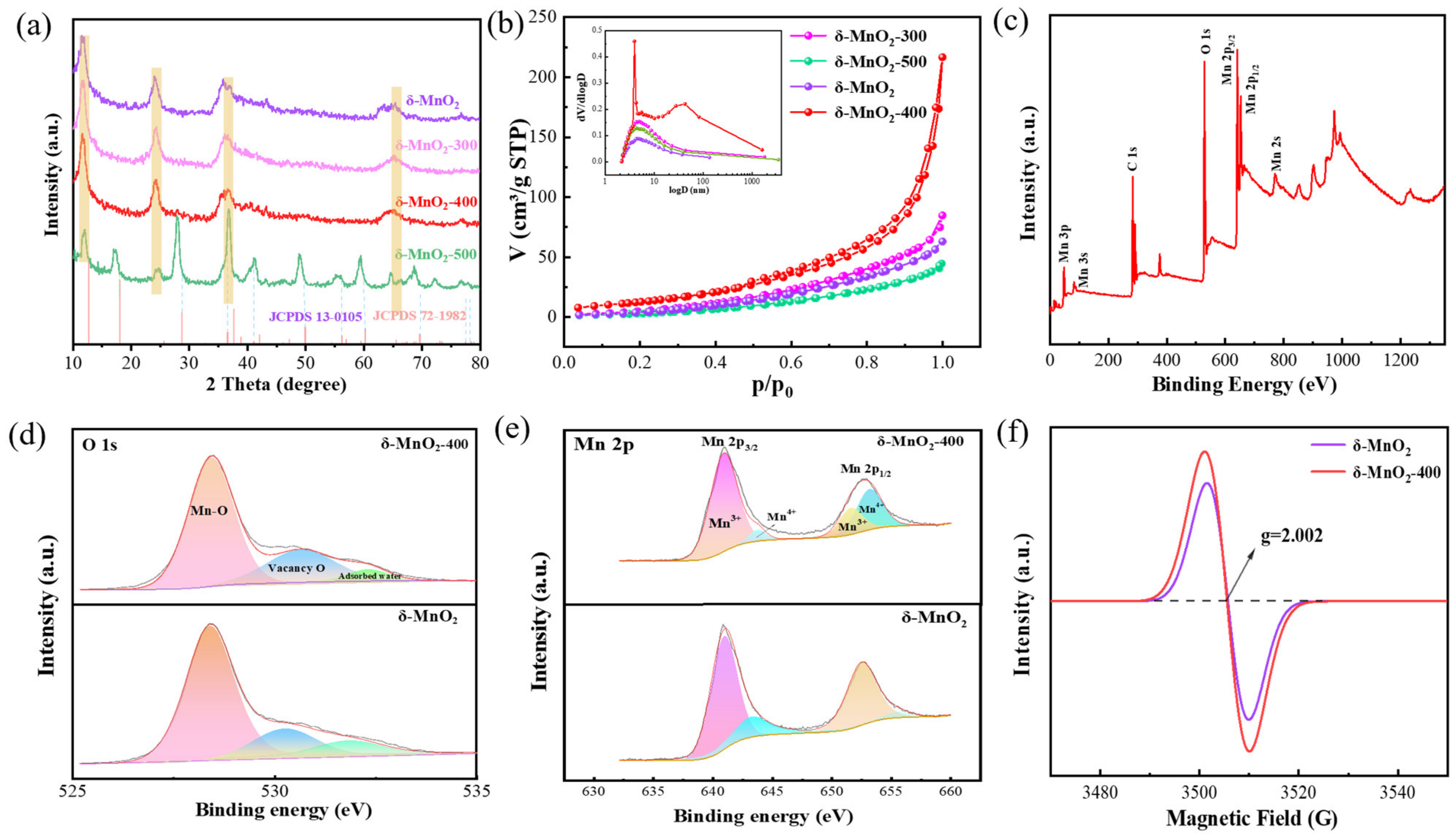

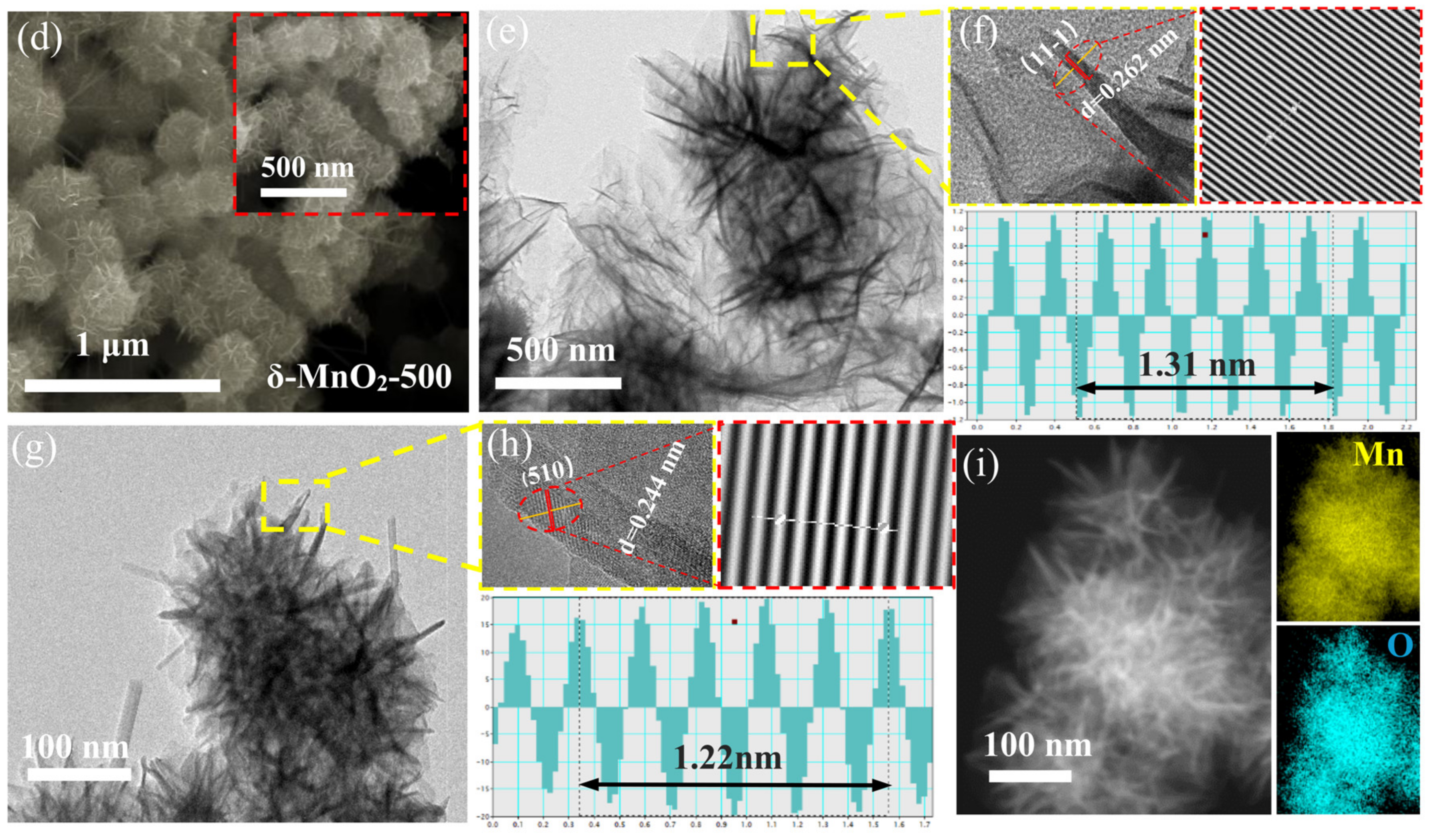
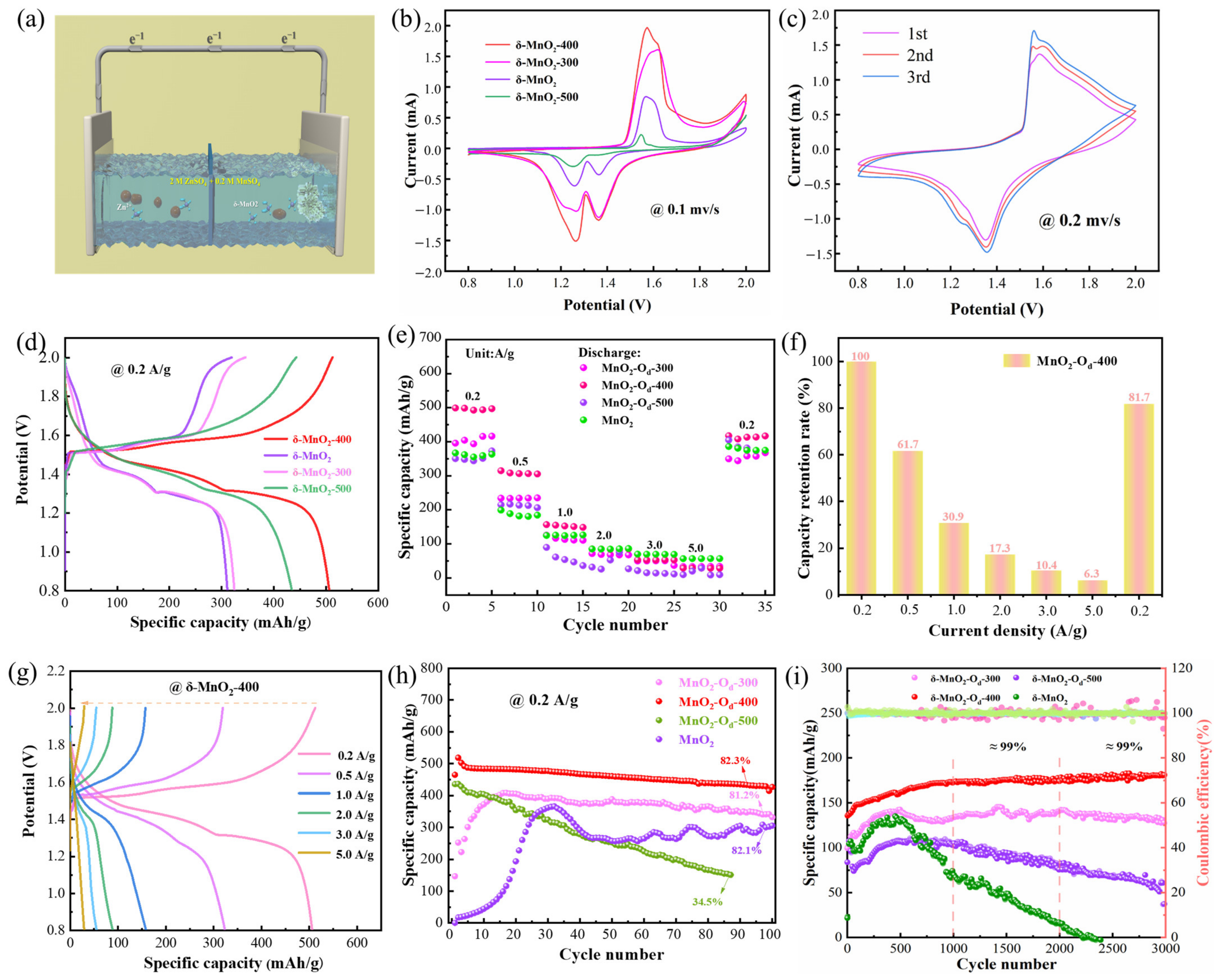
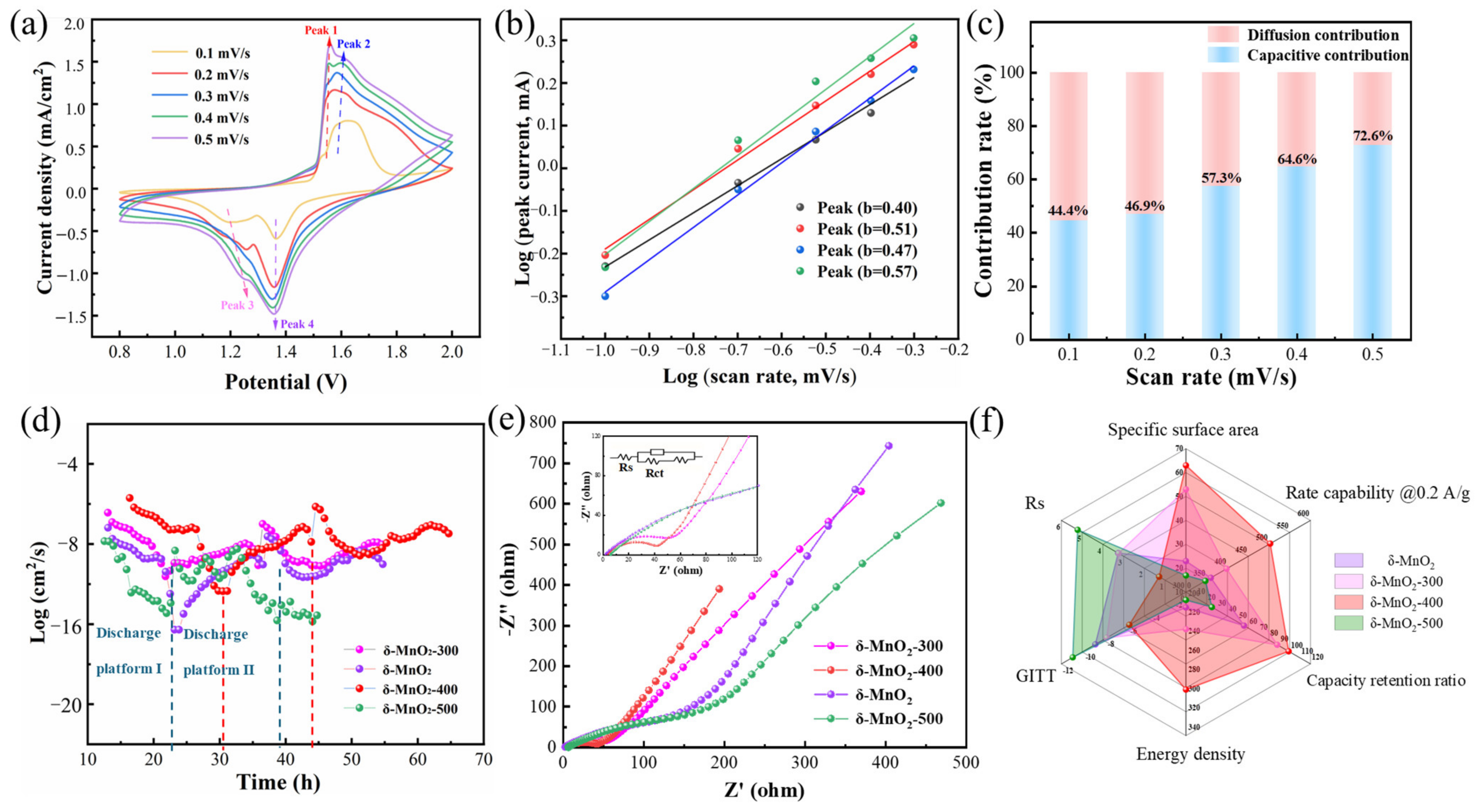
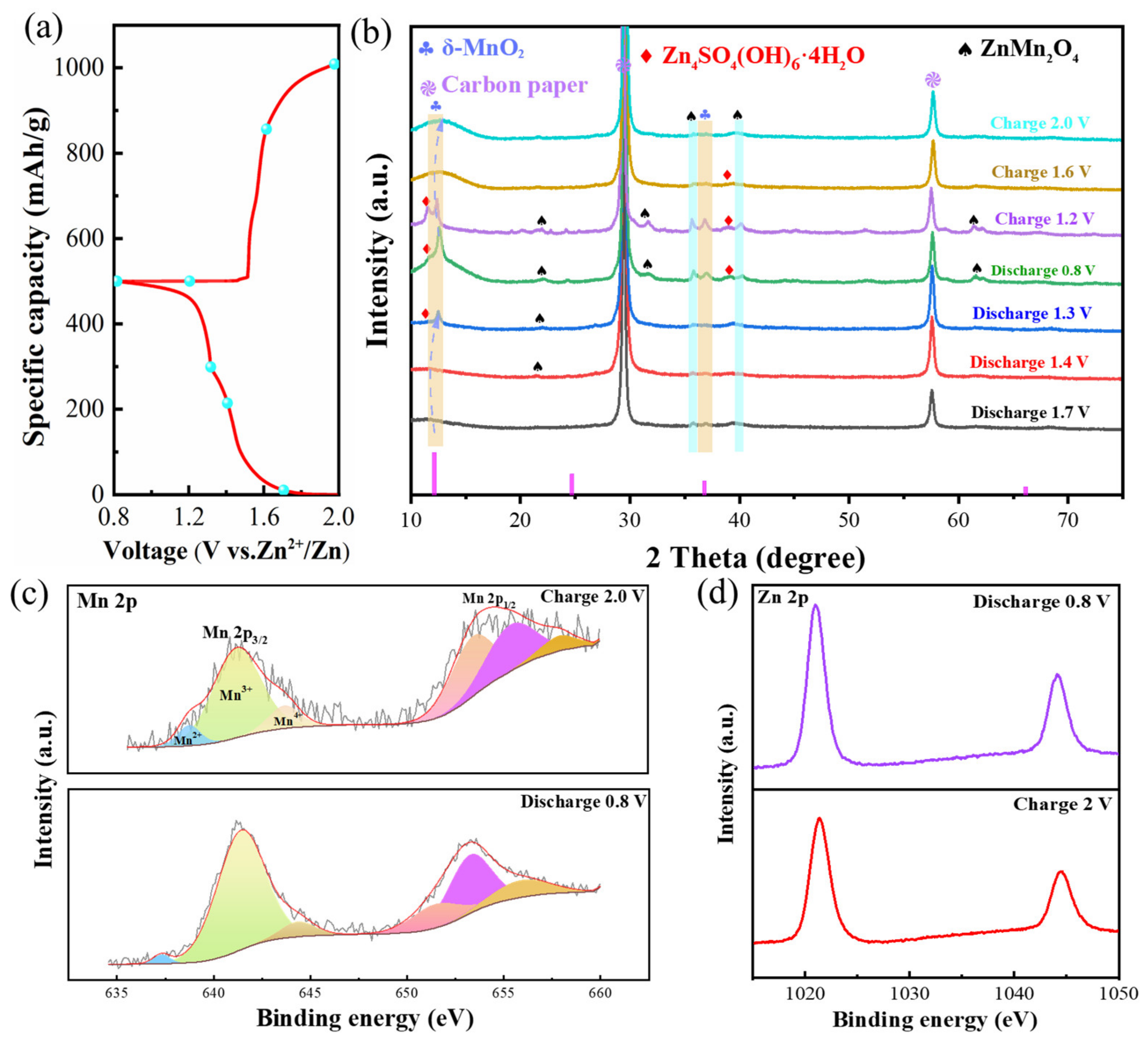
| Materials | Potential Window (V) | Current Density (A/g) | Specific Capacity (mAh/g) | Cycling Stability | Energy Density (W h/kg) | Ref. |
|---|---|---|---|---|---|---|
| Od-HVO | 0.2–1.6 | 0.2/2.0 | 337/334 | 85% | 228 | [47] |
| γ-MnO2 | 0.8–1.8 | 0.05 | 285 | - | - | [48] |
| β-MnO2 | 1.0–1.8 | 0.1 | 100 | - | - | [49] |
| Na+ doping VO2 | 0.2–1.6 | 0.2/12 | 345/156 | ≈95% | 278 | [50] |
| ZnO-QDs-VN | 0.4–1.6 | 0.1 | 384.1 | ≈54% | 209 | [51] |
| α-MnO2 | 1.0–1.85 | C/3/5C | 285/100 | 92% | - | [15] |
| Od-MnO2 | 1.0–1.8 | 0.2 | 345 | 94% | 235 | [52] |
| MnO2@PANI | 1.0–1.85 | 0.2 | 342 | 82% | 199.5 | [53] |
| K-δ-MnO2 | 1.0–1.8 | 0.1/2.0 | 270.3/63.9 | ≈46% | 108.1 | [54] |
| S-MnO2 | 0.8–1.8 | 0.2/2.0 | 324/205 | ≈77% | 194.4 | [55] |
| V-doped MnO2 | 1.0–1.8 | 0.066 | 266 | - | - | [56] |
| δ-MnO2 NDS | 1.0–1.9 | 0.1/2.0 | 335/125 | 86.2% | 233 | [57] |
| δ-MnO2-400 | 0.8–2.0 | 0.2/1.0 | 503/154 | 99% | 300 | This work |
Disclaimer/Publisher’s Note: The statements, opinions and data contained in all publications are solely those of the individual author(s) and contributor(s) and not of MDPI and/or the editor(s). MDPI and/or the editor(s) disclaim responsibility for any injury to people or property resulting from any ideas, methods, instructions or products referred to in the content. |
© 2024 by the authors. Licensee MDPI, Basel, Switzerland. This article is an open access article distributed under the terms and conditions of the Creative Commons Attribution (CC BY) license (https://creativecommons.org/licenses/by/4.0/).
Share and Cite
Li, S.; Wu, X. Oxygen Vacancy-Rich δ-MnO2 Cathode Materials for Highly Stable Zinc-Ion Batteries. Batteries 2024, 10, 294. https://doi.org/10.3390/batteries10080294
Li S, Wu X. Oxygen Vacancy-Rich δ-MnO2 Cathode Materials for Highly Stable Zinc-Ion Batteries. Batteries. 2024; 10(8):294. https://doi.org/10.3390/batteries10080294
Chicago/Turabian StyleLi, Shilong, and Xiang Wu. 2024. "Oxygen Vacancy-Rich δ-MnO2 Cathode Materials for Highly Stable Zinc-Ion Batteries" Batteries 10, no. 8: 294. https://doi.org/10.3390/batteries10080294
APA StyleLi, S., & Wu, X. (2024). Oxygen Vacancy-Rich δ-MnO2 Cathode Materials for Highly Stable Zinc-Ion Batteries. Batteries, 10(8), 294. https://doi.org/10.3390/batteries10080294








